If I were to ask you who led the Cleveland pitching staff in fWAR it’d be pretty grim. First, you have Shane Bieber with 2.3 fWAR but he’s parked on the injured list with a shoulder injury. Then, you have my boy Aaron Civale with 1.2 fWAR and he too has been on the shelf since June 23rd. Closer Emmanuel Clase is tied with Civale with 1.2 fWAR but #4? #4 is surprising. If you hadn’t already guessed it from the title of the article, it’s Cal Quantrill with 0.9 fWAR. I’m sure most of you are asking yourself…who? I wouldn’t blame you. For the record, that 0.9 fWAR would be top 50 in the league if he hadn’t spent the first month or so of the season in the bullpen and as such has not met the qualified IP mark quite yet. Quantrill came to Cleveland two years ago along with Franmil Reyes and Logan Allen in the Mike Clevinger trade and while largely flying under the radar has become a potential long term piece for the newly minted Guardians.
Drafted in 2016 by the Padres, Quantrill made his debut in 2020 with Cleveland with a very promising 32.0 IP to the tune of a 2.25 ERA over 18 games (three starts) and a 23.0 K% working mostly out of the bullpen, which is where he started off in 2021 as well. He threw 28.2 IP in April and May with a 1.88 ERA and 18.2 K%. It’s worth noting here that calling him exclusively a reliever is a bit misleading as he was often utilized in a really unique manner where they would pair him with starters Triston McKenzie or Logan Allen as essentially a second starter to keep their pitch counts low. In these outings, he would throw three or four innings to save the bullpen some innings and get his own pitch count up as well. On May 31st, he shifted to a starting role after Logan Allen struggled to start the season and was sent back down to AAA, but Quantrill struggled as well, throwing 20 IP with a monstrous 7.20 ERA. But in reality, he had three pretty good starts marred by three absolutely disastrous ones.
Then, in July, the switch flipped. Quantrill has been really good, with a 2.36 ERA over 34.1 IP, which included excellent starts against Houston, Tampa Bay, Oakland and the White Sox. He hasn’t given up a single barrel over his last four starts. What could be causing this run of excellence? There are certainly some concerns, as he has just a 15.5 K% and a 9.2 BB%, which is a tough tightrope to walk. Hitters also have a .220 BABIP over that time period and Quantrill holds a 4.86 SIERA this season, so it’s not unfair to wonder if there is a bit of luck in play here as well. So, it’s worth diving in and finding out if the success is for real or not.
First Pitch Strikes
The first thing to understand is much like myself with redheads during my college years, Cleveland seems to have a type. What they want is guys with good breaking pitches and okay fastballs that seem to just need to add velocity and command to make the leap. They really emphasize first-pitch strikes as Zach Plesac, Aaron Civale, and Cal Quantrill all sit in the top 30 in F-Strike% and most years Shane Bieber would be right there with them. They seem to be accumulating a ton of pitchers who have good-to-great changeups and sliders that blur the line between slider and cut fastball. All of these fit Quantrill to a T. In fact, in many ways getting that first-pitch strike is the key to Quantrill’s success, so we’ll start there. Take a look at this 50 game rolling chart comparing his ERA and F-Strike% over the last two years.
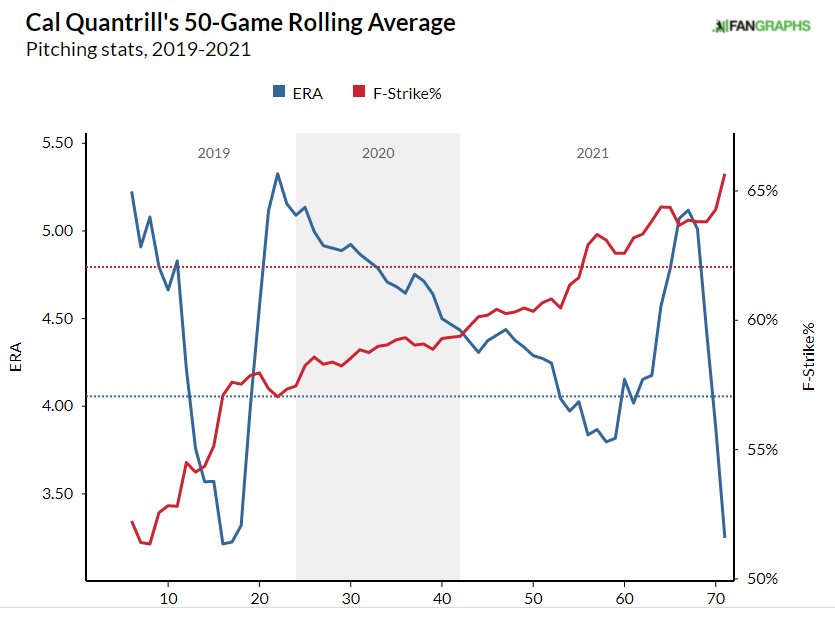
Outside of one blip there at the end, there seems to be clear connection where his ERA goes down as his F-Strike% goes up. This will be something to monitor for Quantrill throughout the season.
Pitching to Contact
The second thing we have to look at is his pitching goals. Most of the time, pitchers are trying for the strikeout, and pitching to contact is frowned upon but when you get someone who is above average at it, it can be really beneficial to get them working east/west and pitching with the goal of getting weak or poor contact while pounding the strike zone. That is what Quantrill does best. Quantrill currently sits at 15th in the league in average exit velocity at 87.4 MPH, has suppressed HRs to the tune of 0.85 HR/9 (20th best in the league), is 30th in HardHit% and 20th in BBL%. You don’t want him to shy away from contact, you actually want a pitcher with that skill set to LEAN into it. Check this out:
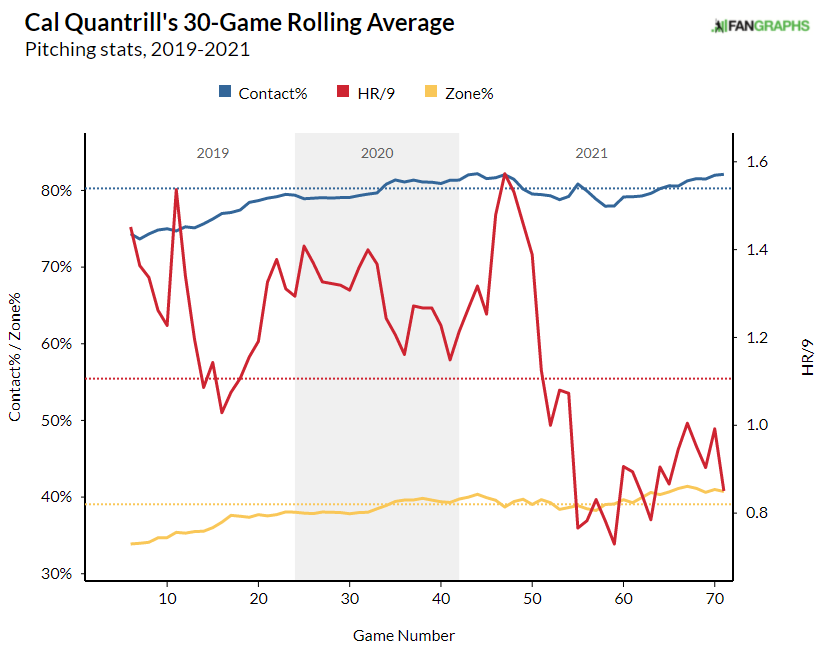
You can see the huge drop in his HR/9 as his zone% and Contact% go up. Combine that with the rising F-Strike% and that indicates to me a pitcher in control of at-bats and getting the kind of contact he wants, rather than trying to work his way back into counts and then making mistakes. Additionally, look at the rolling chart for his launch angle and exit velocity this year:

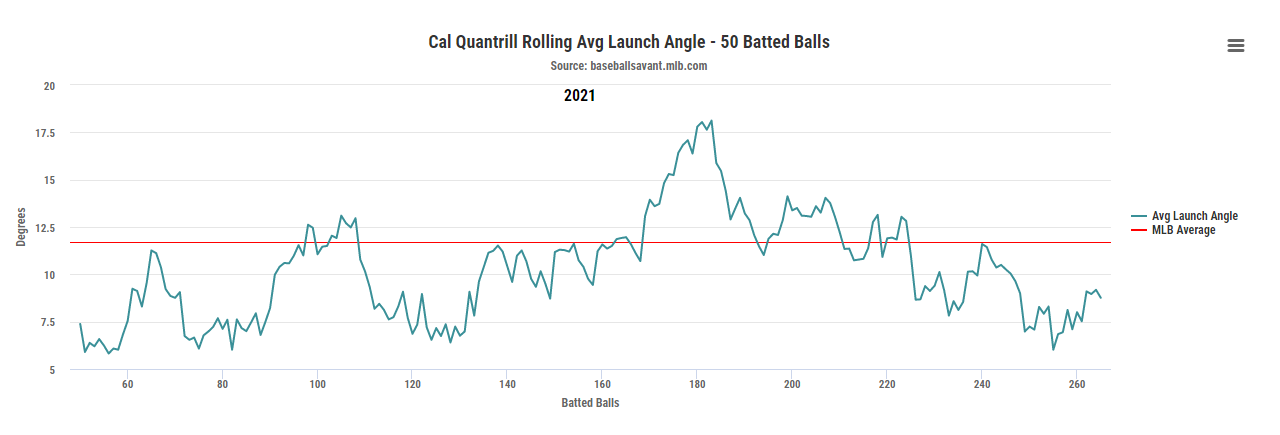
Again it feels counterintuitive that a pitcher getting more contact would generate weaker contact these days but you can see it clear as day, as his Contact% and Zone% go up, his average Launch Angle and Exit Velocity (EV) plummet. Again I firmly believe this is because he’s putting himself in a better position to get the contact he wants.
Now, before we end our examination here, let’s take a look at a couple of his pitches for a moment. We’ll start with the most peculiar change by talking about his slider.
Slider (Cutter?)
When I started my initial look into Cal Quantrill I noticed something peculiar. Fangraphs uses the Pitch f/x system to classify pitches and they claimed has thrown a cut fastball 17.3% of the time in 2021 and that it had been getting stellar results to the tune of a full 4.0 pVAL. This supposed cutter was news to me, so I looked to see what Baseball Savant had to say about this, and lo and behold, they claimed that there were no cutters to be found.
So, what gives? It suddenly occurred to me that I had actually seen this before, in fact, I had seen it most recently when I looked at another Cleveland pitcher right after his rookie season. That’s right, it reminded me of Aaron Civale, who also excels in pitching to contact and controlling at-bats. I remembered that both Pitch f/x and Statcast had a hard time differentiating between Civale’s cut fastball and his slider as well and it’s worth noting they often have the same issue with one of his predecessors, Corey Kluber. Both pitchers had similar movement profiles for these pitches and they blend the two pitches together so that it can be really difficult for a hitter to know which one is coming right up until the cutter blows by them or the slider drips down below the bat. Kluber would often say it’s really just semantics as to whether it’s actually two separate pitches or really just one pitch that they throw slightly differently depending on the situation and it appears that this is also what is happening to some degree with Quantrill’s slider/cutter. Yet, it seems like there is a bit more going on here than originally thought. Check out this box and whisker plot from Fangraphs charting the velocity ranges for the two pitches for each game.
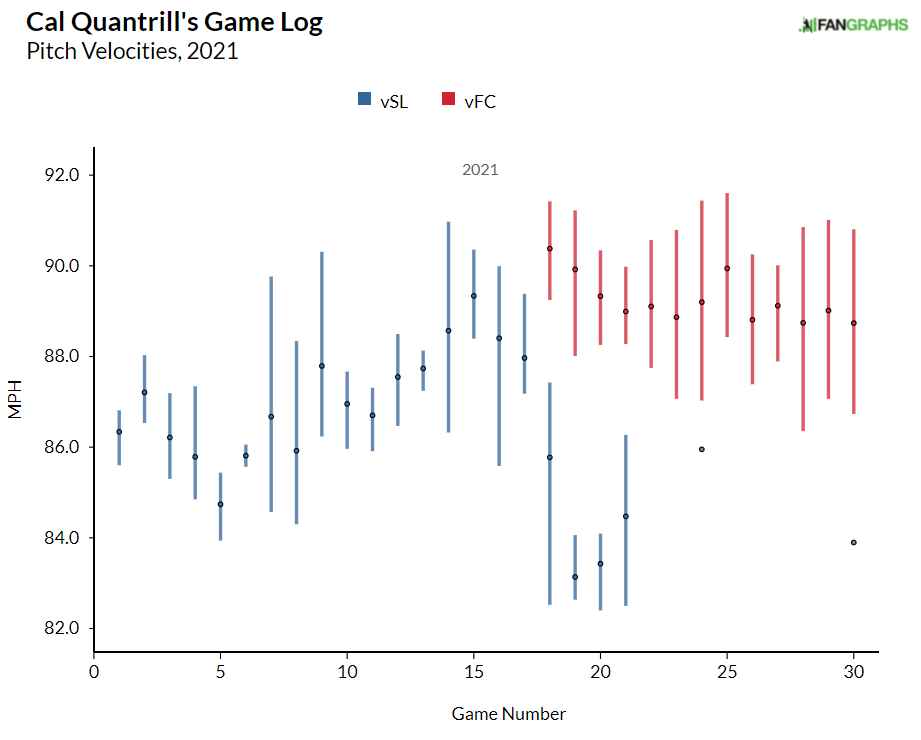
For the first 17 games, we see two things: firstly, he didn’t throw any pitches that were classified as cut fastballs, and secondly, the velocities were all over the place. In some games, the velocities were within a tight range, like in his sixth appearance, and some games you saw a huge range in velocity, like in the very next game, where at least one slider was thrown at 84 MPH and at least one more was thrown at nearly 90 MPH! Now, some of that randomness is a by-product of pitching out of the bullpen. He would only throw a handful of them per outing and we all know small samples can absolutely open the door to random outliers. But in game 18, something changed. Suddenly, we see the first appearances of Quantrill’s cutter (the red boxes). The boxes are consistently tighter and right around 90 MPH. What else is notable about this game? It was Quantrill’s first game back in the starting rotation. So, as a starter, we suddenly saw him throwing a hard cutter in the upper 80s to low 90s and a slider that sat in the mid to low 80s. You can even start to see a difference in the movement of the two pitches, even if it is easy to see how they would blend together well. Check out this slider at just under 86 MPH:
and now the “Cutter” at just under 92 MPH:
That can be really effective when you have two pitches that look really similar (the slider has a bit more bend to it in my eyes) but can be thrown almost seven MPH apart. It’s also worth noting that when he was pitching in relief, Quantrill pitched almost exclusively out of the stretch but the moment he was able to pitch out of a windup we saw a slider/cutter that could get up into the 90s. It’s worth noting too how much outside influences such as the cold Cleveland weather or just early season lower velo played a role in this but it’s clear he was able to take this pitch up a notch once he joined the rotation. Just how good has this pitch been? Consider the cutter and slider to be two different pitches (I draw 88 MPH as the separator between the two pitches in Statcast. It’s not perfect but it gets the idea.) and check this out:
That’s a ton of success to get from two pitches that make up roughly 27.2% of the pitches he’s thrown since he became a starter. It’s not quite enough to propel him into the big time or really project stardom on him yet but it’s a start. There’s one other pitch I want to take a look at and that’s Quantrill’s changeup.
Changeup
Quantrill was billed as having a plus changeup as he worked his way through the Padres’ (and eventually Cleveland’s) minor league system and I’ll admit it has all the makings of a pretty nasty offspeed pitch:
At times, it has flashed some of that potential but he hasn’t really been able to be consistent with it until relatively recently. Over his past 6 starts, his changeup has managed to generate 1.6 pVAL with a .188 AVG, .218 wOBA, 80.9 MPH EV, and a 9-degree Launch Angle. Some of the newfound success is simply that he’s been able to utilize it more often now that he’s starting. Before July 5th (when the current run of changeup success began) he had only thrown the changeup 59 times. Since then he has thrown it 84 times. Relievers don’t often get a chance to work on/rely on their third or fourth offerings and so there are some of his early relief outings where he didn’t throw it much (or at all) and that will always leave its success level vulnerable to small sample randomness.
The other big factor is that he’s commanding it better in his recent starts. Before, he was throwing his changeup in the zone way too often, catching it at nearly a 50% clip. You would much rather see that number settle somewhere between 35 and 40%. That way, it is in the zone enough to keep hitters honest but not so much that they can tee off on it. Since July 5th, though, that Zone% sits at a nice 36.9% which falls in the desired range. It also appears that he is tightening up where he throws his changeup beyond just in and out of the zone. Look at the pitch chart for all his changeups before July 5th:
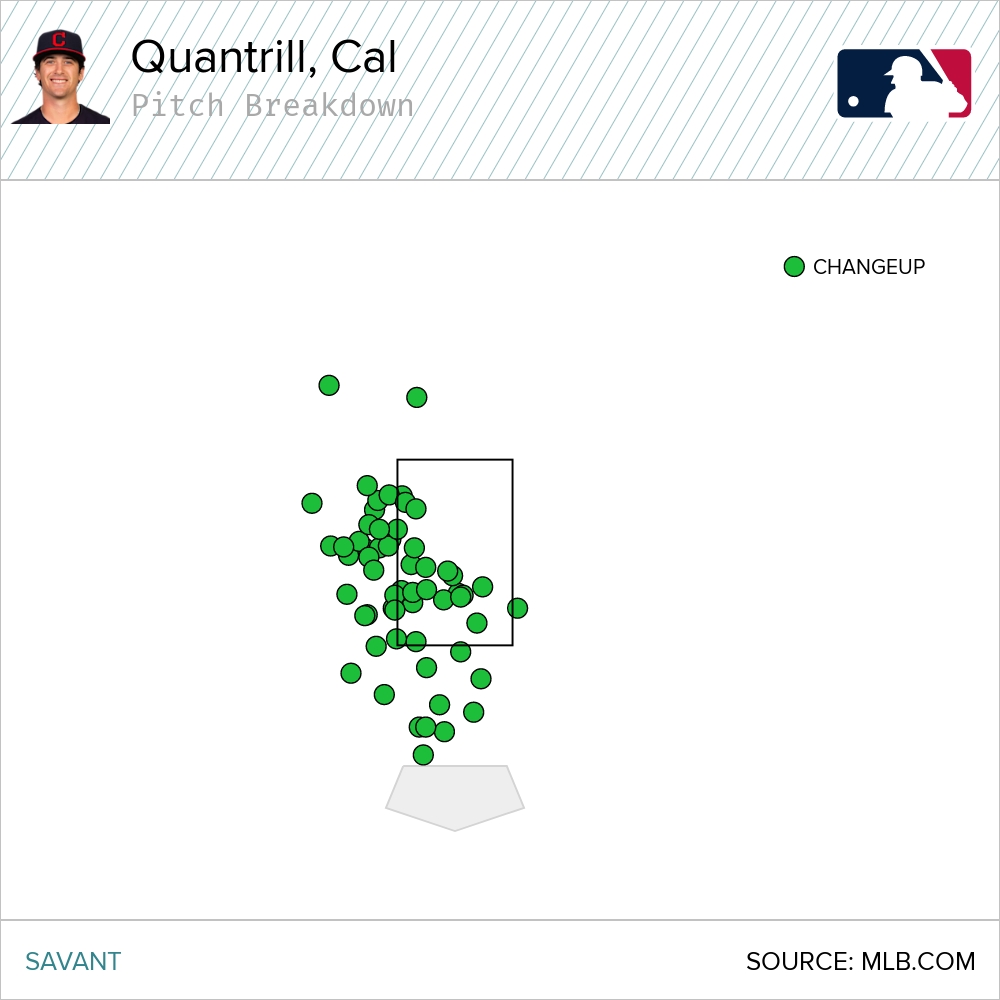
And then for those six starts from July 5th onward:
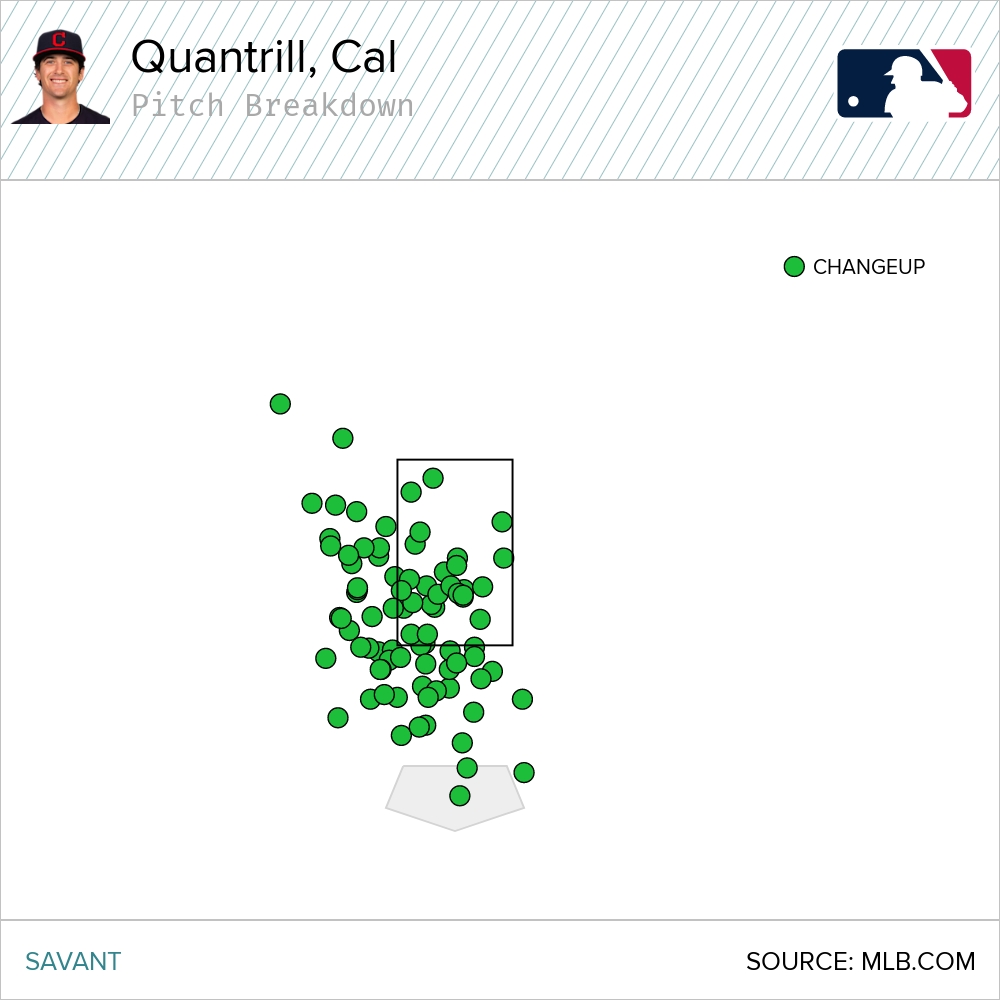
There are two major changes in the groupings. In the first image, you can see the largest concentration of pitches being thrown towards the area that would be in on the hands or out and away to hitters depending on their handedness. When Quantrill threw his changeup there, he wasn’t fooling anyone and it got walloped. In the second image, that grouping has shifted to the bottom of the zone, just barely down and out of the zone. This is the perfect place to throw a changeup, especially one with the vertical break Quantrill’s has. It’ll start out looking like his sinker down in the zone and then suddenly dive down out of the zone. It isn’t currently getting many swings and misses but it’s clearly fooling hitters and playing a bit part in generating weak contact for Quantrill.
Conclusion
So, what does all this say about Cal Quantrill for the rest of the season? I’m not sure yet. There are four major things I’ll be watching.
- Can he continue to start counts off with strikes and use that advantage to control at-bats?
- Can he continue to draw high levels of weak contact?
- Will his cutter/slider combo continue to be effective?
- Can he develop a third consistently above-average pitch?
His skill set is so reminiscent of his teammate Aaron Civale during his rookie year that it’s almost eerie and much like Civale early on, so much of Quantrill’s eventually ceiling will be dependent on whether or not he can find a third pitch (or second I suppose) to compliment the cutter/slider combo and give him more than one way to get hitters out. His sinker is essentially a net neutral pitch so far and that’s perfectly fine. Cleveland is great at developing good pitchers around meh fastballs. The changeup has shown some signs lately of living up to the scouting reports and if that can continue and the sinker can simply hold its own then we might be looking at a pitcher who can occupy the middle to back end of a rotation for a long time.
For this year, I’m expecting something between a 3.50 and 4.00 ERA the rest of the way and for Quantrill to make a real bid to lock down a spot in the rotation heading into Spring Training next year. For you fantasy players, I don’t know if he’ll have the strikeouts to win you your league or anything but he gets Detroit at home tomorrow and it looks like his next several starts are lining up to be some combination of Oakland, Minnesota, and either the Angels or the Rangers, so he could hold some value for your ratio plays if nothing else. If he can continue making strides along with the criteria I’ve outlined above, you’ll be seeing a lot of sleeper picks or breakout predictions centered around Quantrill.

Great analysis.
Since I have the benefit of having the stats on the entire 2022 season, here are some thoughts.
First the disclosure that I have Quantil on my Points Fantrax League where his “salary” at $1720
for 439 projected points is almost half of the top salary (Cole) of $3150 for 601 projected points. He is a good “Value”
In my league a win is 10 points, K and IP are both 1 point.
Because Cleveland will win the division again (92-70 2022) that means lost of wins for Quantil who had 15 W last year.
The lineup has improved – a whole year of Gimenez 2B 837 OBP -Kwan who hit .298 – Oscar Gonzales who hit .296 –
Bell added at 1B who had 27 HR in 2021 and 837 OBP – Naylor who went 771 OBP not full season either.
I think Cleveland could win 100 games. Last year they went 698 to 634 in runs for vs. runs against.
That plus 64 was the lowest of any division winner. They will score more runs in 2023.
Your astute analysis did not have the last two months stats. Quantril went from 3.75 to 2.94 ERA in the second half
Went from 30/63 to 17/65 BB to K’s and reduced earned runs from 47 to 31 in the second half.
I think he gets 14 -15 wins and pushes his K’s close to 165-170 which could be a top 25 in points leagues.